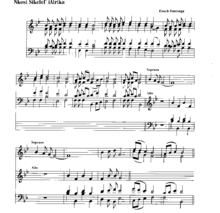
Back Nkosi Sikelel' iAfrika Afrikaans ইশে কোম্বোরেরা আফ্রিকা Bengali/Bangla Nkosi Sikelel' iAfrika Welsh Nkosi Sikelel’ iAfrika German Nkosi Sikelel' iAfrika Spanish Nkosi Sikelel’ iAfrika Finnish Nkosi Sikelel' iAfrika French Nkosi Sikelel' iAfrika Irish Nkosi Sikelel' iAfrika ID Nkosi sikelel' iAfrika Italian
| English: Lord Bless Africa | |
|---|---|
 | |
Former co-national anthem of South Africa Former national anthem of Namibia and Zambia | |
| Lyrics | Enoch Sontonga, 1897 |
| Music | Enoch Sontonga, 1897 |
| Adopted | 10 May 1994 (by South Africa) 21 March 1990 (by Namibia) 24 October 1964 (by Zambia) |
| Relinquished | 10 October 1997 (by South Africa) 17 December 1991 (by Namibia) 14 September 1973 (by Zambia) |
| Preceded by | "Die Stem van Suid-Afrika" (South Africa & Namibia) "God Save the Queen" (Zambia) |
| Succeeded by | "National anthem of South Africa" (South Africa) "Namibia, Land of the Brave" (Namibia) "Stand and Sing of Zambia, Proud and Free" (Zambia) |
| Audio sample | |
"Nkosi Sikelel' iAfrika" (instrumental) | |
"Nkosi Sikelel' iAfrika" (Xhosa pronunciation: [ŋkʼɔsi sikʼɛlɛl‿iafrikʼa], lit. 'Lord Bless Africa') is a Christian hymn originally composed in 1897 by Enoch Sontonga, a Xhosa clergyman at a Methodist mission school near Johannesburg.
The song became a pan-African liberation song and versions of it were later adopted as the national anthems of five countries in Africa including Zambia, Tanzania, Namibia and Zimbabwe after independence, and South Africa after the end of apartheid. The song's melody is still used as the national anthem of Tanzania and the national anthem of Zambia (Zimbabwe and Namibia have since changed to new anthems with original melody composition).
In 1994,[1] Nelson Mandela decreed that the verse of Nkosi Sikelel' iAfrika be embraced as a joint national anthem of South Africa; a revised version additionally including elements of "Die Stem" (the then co-state anthem inherited from the previous apartheid government) was adopted in 1997. This new South African national anthem is sometimes referred to as "Nkosi Sikelel' iAfrika" although it is not its official name.
The hymn is also often considered the unofficial African "national" anthem. According to anthropologist David Coplan: " 'Nkosi Sikelel' iAfrika' has come to symbolize more than any other piece of expressive culture the struggle for African unity and liberation in South Africa."[2]
- ^ "South Africa (1994-1997) – nationalanthems.info". Archived from the original on 1 June 2018.
- ^ Coplan, David B.; Jules-Rosette, Bennetta (2004). " 'Nkosi Sikelel' iAfrika': From Independent Spirit to Political Mobilization". Cahiers d'Études Africaines. 44 (173/174): 343–367. doi:10.4000/etudesafricaines.4631.
© MMXXIII Rich X Search. We shall prevail. All rights reserved. Rich X Search